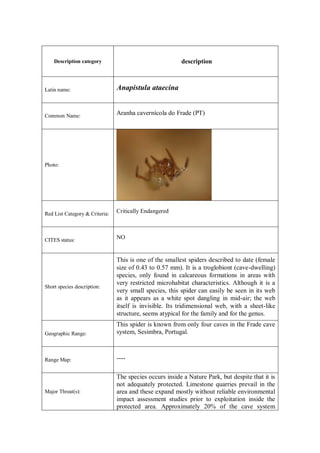
Anapistula
- 1. Description category description Latin name: Anapistula ataecina Common Name: Aranha cavernícola do Frade (PT) Photo: Red List Category & Criteria: Critically Endangered CITES status: NO This is one of the smallest spiders described to date (female size of 0.43 to 0.57 mm). It is a troglobiont (cave-dwelling) species, only found in calcareous formations in areas with very restricted microhabitat characteristics. Although it is a Short species description: very small species, this spider can easily be seen in its web as it appears as a white spot dangling in mid-air; the web itself is invisible. Its tridimensional web, with a sheet-like structure, seems atypical for the family and for the genus. This spider is known from only four caves in the Frade cave Geographic Range: system, Sesimbra, Portugal. Range Map: ---- The species occurs inside a Nature Park, but despite that it is not adequately protected. Limestone quarries prevail in the Major Threat(s): area and these expand mostly without reliable environmental impact assessment studies prior to exploitation inside the protected area. Approximately 20% of the cave system
- 2. where the species is found has already been destroyed by nearby limestone quarries. Within this cave system and the limestone quarries lies the Gruta do Zambujal, a cave protected by national laws since 1979 (Decreto-Lei no. 140/79). A single visit to this cave did not reveal any individuals of Anapistula ataecina, even though the geological structure of this cave seems suitable for the species. Unfortunately, the cave is now much degraded. Changes in the internal microclimate caused by the exposure of the cave during mining activities may have caused the species to go locally extinct. In addition to quarrying activities, tourism may also have an impact on the species. The Portuguese Institute for Nature Conservation has recently authorized tourist activities inside Gruta do Fumo, where most specimens of this spider were found. This authorization was granted in the absence of any previous environmental impact assessment studies. Despite the cave system being located inside a Nature Park the stone quarries are expanding. Numerous conservation initiatives were proposed by a local speleology association, but these have not been implemented or authorized by the national authorities: 1. To force the limestone quarries to obey the existing laws imposing the minimum distance that any quarry Conservation Actions: should be from protected areas or the ocean (500 m). 2. To close Gruta do Zambujal in order to restore the natural air flow and microclimate. 3. To protect the cliffs opened by the limestone quarries surrounding Gruta do Zambujal from erosion and to guarantee their geological stability. 4. To establish and enforce strict guidelines for the future touristic visits to the Frade cave system. IUCN base link: http://www.iucnredlist.org/apps/redlist/details/176265/0 http://www.iucnredlist.org/apps/redlist/details/176265/0 http://naturdata.com/Anapistula-ataecina-38071.htm Sources:
